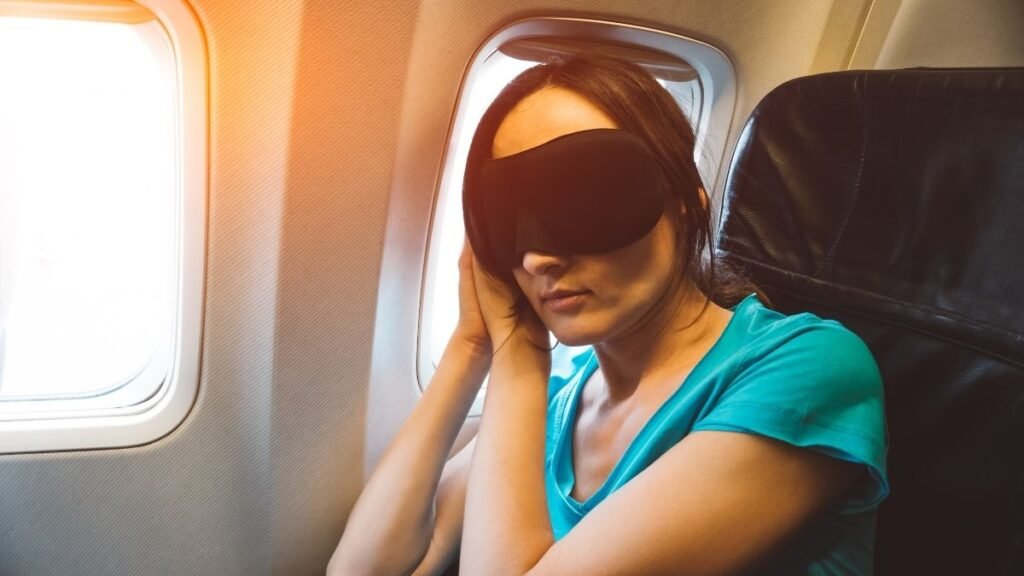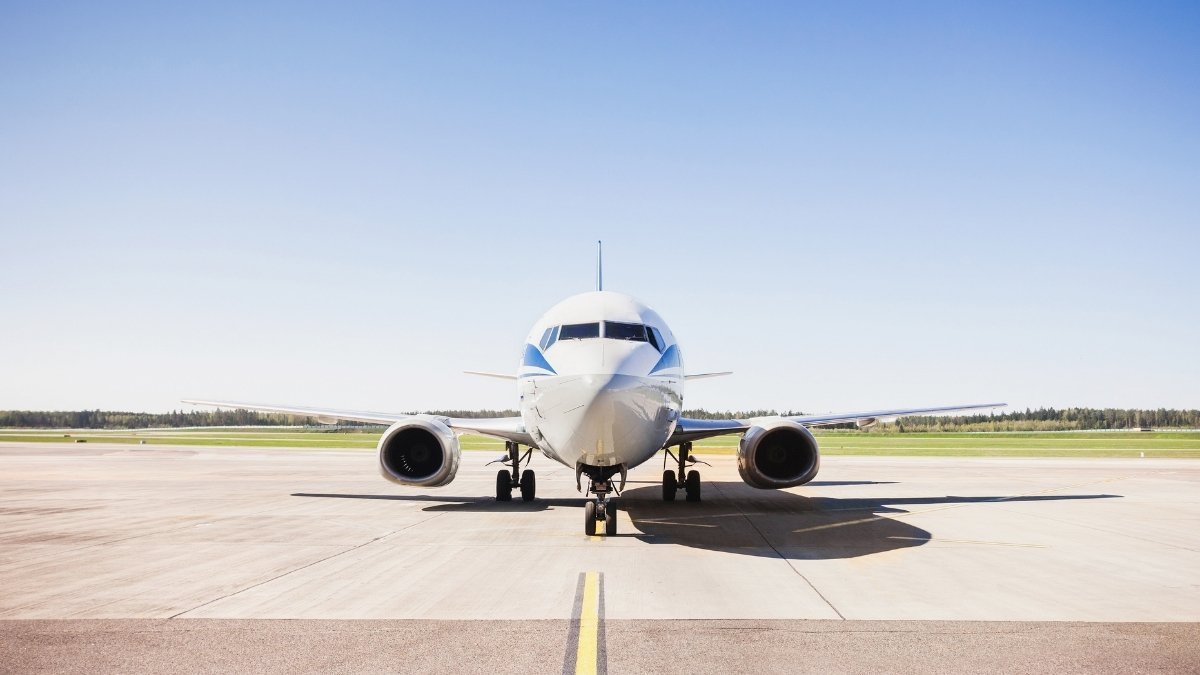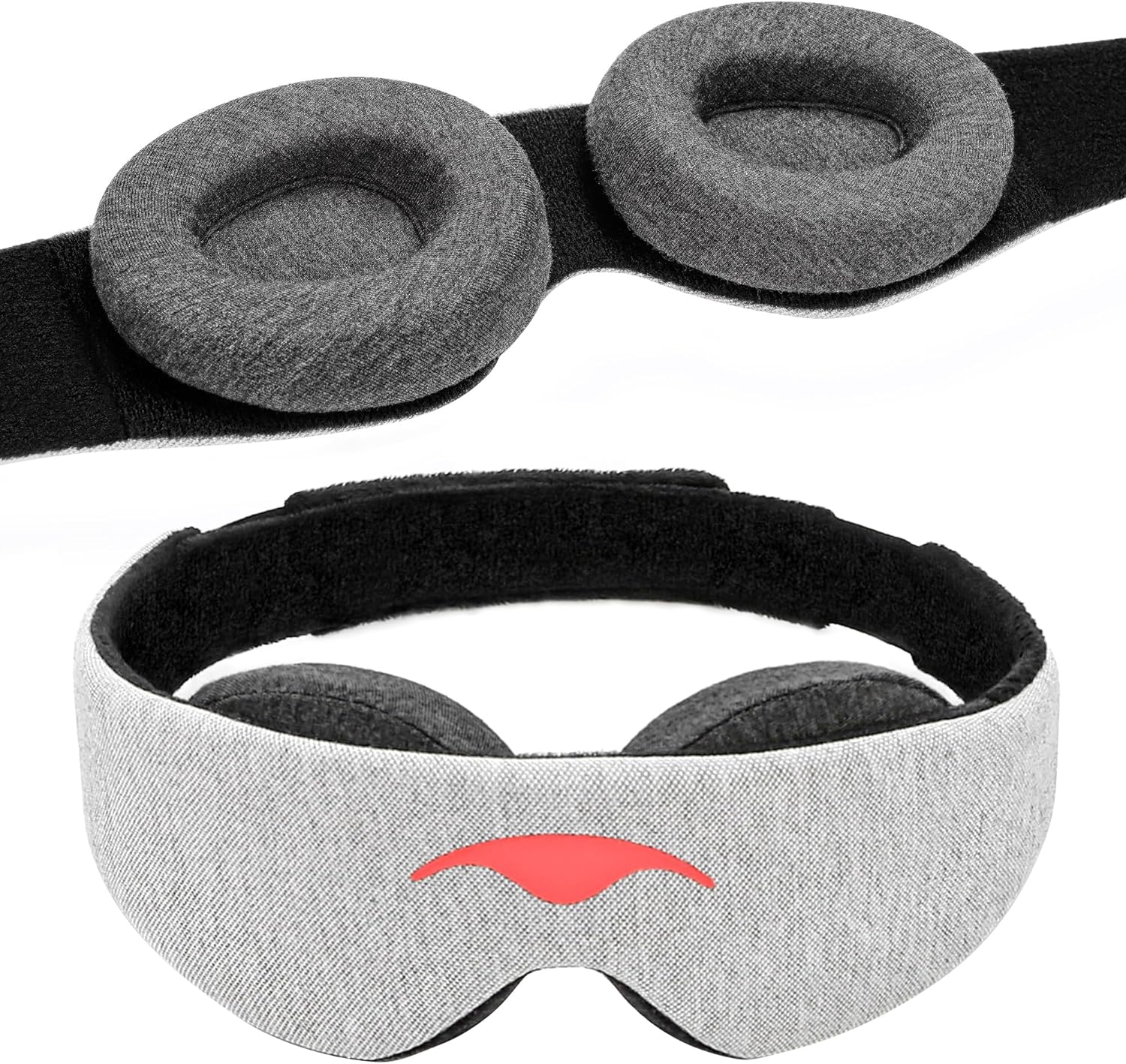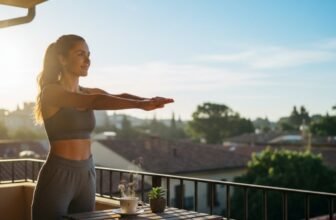
Day one of your big trip. You’re in Paris, Tokyo, or London. You should be excited. Instead, your brain feels like it’s packed in cotton wool, your stomach is protesting, and all you can think about is a pillow. A well-meaning friend texts you the standard, terrible advice: “Whatever you do, just stay awake until 10 p.m.!”
It’s impossible. You feel like a zombie. By 3 p.m., you’re irritable and foggy, and you end up crashing for a “quick nap” that accidentally lasts four hours. You wake up at 7 p.m., totally disoriented, and realize you’ve just ruined your sleep for another night.
You’ve just lost the first two days of your trip. And it’s infuriating.
Here’s the good news: It’s not your fault. You’re fighting a two-front war, and you were only given the battle plan for one.
That “brain fog” you feel isn’t just “jet lag.” It’s a combination of two separate physiological insults that gang up on you. And once you understand them, you can finally beat them.
The Two-Front War: Why You Feel So Awful

We’ve all been told that “jet lag” is about your internal clock being out of sync. That’s true, but it’s only half the story. The crushing fatigue you feel is a 1-2 punch.
Front #1: The “Clock” Problem (Process C)

This is the one you know about. It’s “jet lag” proper, or what scientists call desynchronosis.
Think of it this way: You have a master clock in your brain (specifically, the suprachiasmatic nucleus) that runs your body’s 24-hour operating system. This clock tells you when to feel awake, when to feel sleepy, when to get hungry, and when to release hormones. Its main cue for setting itself? Sunlight.
When you fly from New York to Paris, you cross six time zones. Your body arrives, but your brain clock is still 3,000 miles away. So at 7 a.m. in Paris, when the sun is up and you’re supposed to be eating a croissant, your brain clock is screaming that it’s 1 a.m. and time for deep sleep. This misalignment is the “jet lag” part—your internal schedule is fighting the external world.
Front #2: The “Battery” Problem (Process S)

This is the one nobody talks about, and it’s the real culprit for that “Day 1” misery.
Separate from your 24-hour clock, your body also has a “sleep battery,” or what scientists call homeostatic sleep drive. It’s a simple system: the longer you’re awake, the more a chemical called adenosine builds up in your brain, increasing the “pressure” to sleep. This pressure is your sleep debt. When you sleep, you clear out the adenosine, and the battery recharges.
Here’s the problem. Most of us aren’t starting our trip with a full battery. An estimated 1 in 3 American adults already doesn’t get enough sleep. We’re all walking around with a low-grade, chronic sleep debt before we even pack.
Then, travel itself makes it worse. That flight you woke up at 4 a.m. for? You just added to the debt. Trying to sleep sitting upright on a plane? Not restorative.
So, you don’t just land with a broken clock. You land with a completely dead battery.
That’s why the “just stay awake” advice fails. You’re trying to fix the clock problem (Process C) while being completely crippled by the battery problem (Process S). You’re asking a person who just pulled an all-nighter to somehow have the willpower to go sightseeing. It’s not going to happen. To win, you have to fight both wars. And you have to start with the battery.
The Big Debate: Can You Really “Bank” Sleep?

This brings us to a strategy called “sleep banking,” or more accurately, Prophylactic Sleep Extension (PSE). The idea is simple: in the week before you travel, you intentionally sleep more than you normally do to build up a reserve.
But does it actually work? This is where things get confusing, because you’ll hear experts give what sound like opposite answers.
The “Myth” Camp: You’ve probably heard this. Dr. Matthew Walker, a famous sleep researcher, has said, “Unfortunately, you cannot catch up on sleep. Sleep is not like the bank… You can’t accumulate a debt… and then hope to pay it off at the weekend”. He calls this weekend binge-and-purge cycle “sleep bulimia,” and he’s right—it’s not an effective long-term strategy.
The “It Works” Camp: On the other side, you have researchers from places like the Walter Reed Army Institute of Research. Neurobiologist Dr. Allison Brager cites “about 30 published studies” that support the concept. Dr. Tom Balkin, another senior scientist from Walter Reed, embraces the metaphor: “Think of it like money. The more you get… The next day, the money is still in your account”.
So, who’s right? The famous Stanford guy or the U.S. Army?
The Answer: They’re both right. They’re just talking about two different things.
Dr. Walker is talking about reactive “catch-up sleep”—trying to pay back a debt after you’ve already incurred it. That’s like trying to pay off a credit card after you’ve already maxed it out. It’s slow, and the damage (the interest) is already done.
The Walter Reed researchers are talking about a proactive, pre-emptive strategy—what we’re calling PSE. This isn’t about “catching up.” It’s about loading up.
Here’s the best way to think about it: You’re not “banking” a surplus of sleep. You’re simply paying off that chronic, low-grade sleep debt that 1 in 3 of us carries around. You’re ensuring you start your trip at a true 100% battery level, a state most of us rarely experience.
This isn’t “banking.” It’s “homeostatic saturation.” You’re starting the race fully hydrated, not thirsty.
The Real Magic: Why “Banking” Is Your Secret Weapon

This is where it all comes together. Lowering your sleep debt before you fly doesn’t just make you feel a little better. It fundamentally changes the game in two ways.
1. It Creates a “Buffer” for Your Battery (Process S)

Starting with a fully charged battery makes you more resilient. When the sleep deprivation of travel does hit, it takes you much, much longer to drop into that red zone of cognitive failure. As Dr. Brager noted, the performance drop is “a slow, gradual decline… rather than an immediate change”. You’re giving yourself a bigger buffer before you hit empty.
2. It Enables You to Fix Your Clock (Process C)

This is the most important part. Remember our two-front war? Research shows that when your sleep pressure (your “battery” problem) reaches a high enough level, it can completely overwhelm your circadian clock.
In other words, your high Process S hijacks your Process C.
That’s what’s happening when you collapse for that 3 p.m. nap. Your body’s desperate need for sleep (Process S) is so powerful that it completely steamrolls your brain’s clock signals (Process C) that are trying to keep you in sync with the local sunlight.
But when you “bank” sleep? Your Process S pressure is low. It’s not screaming for an emergency shutdown. This means your circadian clock (Process C) is allowed to stay in the driver’s seat. You’re still misaligned, but you have the mental and physical capacity to choose to stay awake, go outside, and get that critical sunlight.
By solving the battery problem first, you are finally free to solve the clock problem. You’re only fighting one war now, not two.
The Hard Data: This Isn’t Just a “Feeling”

The benefits are real, and they’re quantifiable.
First, let’s look at the baseline. Studies on partial sleep deprivation—the kind 1 in 3 of us live with—are terrifying. One seminal study showed that restricting people to 6 hours of sleep a night for 14 days resulted in cognitive deficits equal to being awake for two full nights. The worst part? The subjects thought they were doing fine. Their performance was collapsing, but their subjective feeling of sleepiness plateaued. You can’t trust your own brain when you’re sleep-deprived.
Now, look at what “banking” does:
- It Boosts Reaction Time: One study on professional baseball players found that 5 nights of sleep extension (getting just 0.6 hours more sleep a night) improved their cognitive processing speed by 13%. They reacted 122 milliseconds faster. For an athlete, that’s the difference between a hit and a strike. For you, it’s the difference between sharp and “fuzzy.”
- It Keeps You “Sober”: This is a killer stat. A study on medical residents (a group that knows sleep deprivation) compared those who used “Sleep Banking” before a block of night shifts to those who didn’t. The “No Change” group spent 35.75% of their shift at a cognitive impairment level equivalent to a blood alcohol (BAC) of 0.05%. The Sleep Banking group? Only 13.45% of their time was spent in that “functionally drunk” state. Who do you want to be in your 9 a.m. business meeting?
- THE REAL GOLD: It Speeds Up Your Recovery. This is the whole secret. A landmark 2009 study (Rupp et al.) did exactly what we’re talking about. They had one “Extended” group bank sleep for a week, and a “Habitual” group stuck to their normal (already-in-debt) schedule. Then, they put them both through severe sleep restriction.
Here’s what happened: During the recovery phase (getting 8 hours of sleep), the “Extended” group’s performance on attention tasks bounced back after just one night.
The “Habitual” group? Their performance was still impaired even after five full nights of recovery sleep.
I’m going to say that again. The people who started with a “normal” sleep debt spent their entire 5-day recovery period in a state of cognitive impairment. The people who banked sleep were back to 100% by Day 2.
This is the entire ballgame. This is the difference between a 4-day trip where you’re fully functional by Day 2, and a 4-day trip where you spend the whole time feeling foggy and only start to feel normal on the flight home.
The Complete Anti-Jet Lag Protocol (Process S + Process C)

A successful plan must be an integrated, two-system strategy. First, you fix the battery (Process S), then you fix the clock (Process C).
Phase 1: The Week Before You Fly (T-7 to T-1 Days)

1. The Process S Fix (The “Bank”):
- Action: For 5-7 nights before your trip, add 60-90 minutes of extra sleep per night.
- Method: This is critical. You must do this by going to bed 1-1.5 hours earlier. Do not do this by “sleeping in.” (See the warning section on why!). If you can’t go to bed earlier, a 20-30 minute daily nap can help.
- Key Principle: Do not intentionally deprive yourself of sleep before a flight, thinking it will help you sleep on the plane. This is the single worst mistake you can make. It maximizes your sleep debt and guarantees you’ll land in that “functionally drunk” state.
2. The Process C Fix (The “Advanced” Move):
- Goal: Start shifting your clock before you even leave.
- Action (Eastward Travel): For 3 days before your flight, move your bedtime and wake time 1 hour earlier each day. This works perfectly with the “go to bed earlier” step from the Process S fix.
- Action (Westward Travel): For 3 days before your flight, move your bedtime and wake time 1 hour later each day.
- Pro-Tip: Pair this with timed light. For eastward travel, get 30-90 minutes of bright light (from the sun or a 10,000-lux light box) immediately upon waking. For westward, get it in the evening.
Phase 2: On the Plane and When You Land (T-0 to T+3)

1. Go With the Local Flow
- Action: The second you get on the plane, change your watch and phone to your destination’s time.
- Action: From that moment on, all your decisions—eating, sleeping, working—are guided by the new time, not your home time. If it’s 2 a.m. in your destination, close your eyes. If it’s 10 a.m., turn on the light and read.
- The “Two-Day Rule” Exception: If your trip is super short (fewer than 2 days), ignore all this. It’s counter-productive. Just stay on your home schedule as much as possible.
2. Master Your Cues: Light and Melatonin
These are powerful, clock-shifting tools. Using them at the wrong time can make your jet lag worse.
- Light (The “On” Switch): Sunlight is your most powerful tool.
- Eastward Travel (e.g., USA to Europe): You need to advance (move earlier). Seek bright MORNING light. Just as important: Avoid late afternoon light. Wear sunglasses if you’re out after 4 p.m.. Afternoon light sends a “delay” signal, fighting your goal.
- Westward Travel (e.g., USA to Asia): You need to delay (move later). Avoid bright MORNING light (wear sunglasses). Seek strong AFTERNOON and EARLY EVENING light to push your clock later.
- Melatonin (The “Darkness” Switch): This isn’t a sleeping pill; it’s a darkness signal.
- Dosage: More is not better. Studies show 0.5mg to 3mg is effective. A 5mg+ dose just increases side effects.
- Timing (Eastward Travel): Take your 0.5-3mg dose 30 minutes before your new, earlier bedtime.
- Timing (Westward Travel): This is the weird one. To help delay your clock, you take the melatonin in the morning at your destination (Always talk to your doctor before starting a new supplement).
The One Big Warning: How to Do This Safely

This protocol is powerful, but it has one major risk. You can mess this up. Warning: “Sleep Banking” is NOT a Long-Term Fix
This is a short-term tool for a specific, known event (like travel or a big deadline). It is not a substitute for a healthy, consistent 7-9 hours of sleep. As Dr. Lancelot Mark Pinto says, “Use it like a safety net, not a trampoline”. Trying to live in a “sleep bulimia” cycle will, in the long run, hurt your health.
The Critical Rule: Go to Bed Earlier, Do NOT Sleep In. This is the most important part of the whole plan.
Why? “Sleeping in” (delaying your wake time) shifts your circadian clock later. This is a disaster if you’re flying east, as you’re actively moving your clock in the wrong direction before you even leave.
This is called “social jet lag,” and it’s why some studies on “profound” sleep extension show weirdly negative effects, like increased inflammation and depression. The participants weren’t just getting more sleep; they were getting poorly timed sleep that was fighting their internal clock.
The solution is simple and non-negotiable: You MUST “bank” your sleep by going to bed earlier.
This one tweak is the key. It adds to your “battery” (Process S) without breaking your “clock” (Process C).
So, next time you travel, stop bracing for impact. Take control. Start a week out. Pay down your sleep debt by going to bed an hour earlier. Arrive with a full battery. You’ll land with only a clock problem, and now you have the energy, resilience, and mental clarity to fix it.
You’re not fighting two wars anymore. You’re just fighting one. And that’s a fight you can win.
A Few Tools That Can Make a Real Difference
Look, the “sleep banking” strategy and mastering your clock are the most powerful things you can do, and they’re completely free. But let’s be real: sleeping on a plane is tough. For that, having a few key items in your carry-on can be the difference-maker. These aren’t magic pills, but they are smart tools that support the protocol we just talked about, helping you create a “sleep-ready” bubble so you can actually rest.
1. Pure Encapsulations Melatonin

The protocol mentions using low-dose melatonin to signal darkness to your brain. This version is ideal for clock-shifting without the grogginess of higher doses.
2. Manta Sleep Mask

This is key for the “light avoidance” part of the plan. This mask is consistently rated as providing 100% blackout with no eye pressure, letting you create total darkness even when the cabin lights are on.
3. Ostrichpillow Go Neck Pillow

You can’t “bank” sleep or rest on a plane if you’re in pain. This pillow provides ergonomic neck support that’s a significant upgrade from the standard C-shaped pillows, helping you actually relax.
4. Loop Dream Earplugs

Noise is the other half of the battle. These earplugs are specifically designed with soft silicone to be comfortable for side sleepers and are highly effective at blocking out engine hum and cabin noise.
5. Basic Concepts Airplane Foot Hammock

This is a clever tool for tackling the other big barrier to in-flight sleep: leg discomfort. By letting you elevate your feet, it helps with circulation and makes it easier to find a comfortable resting position in a cramped economy seat.






